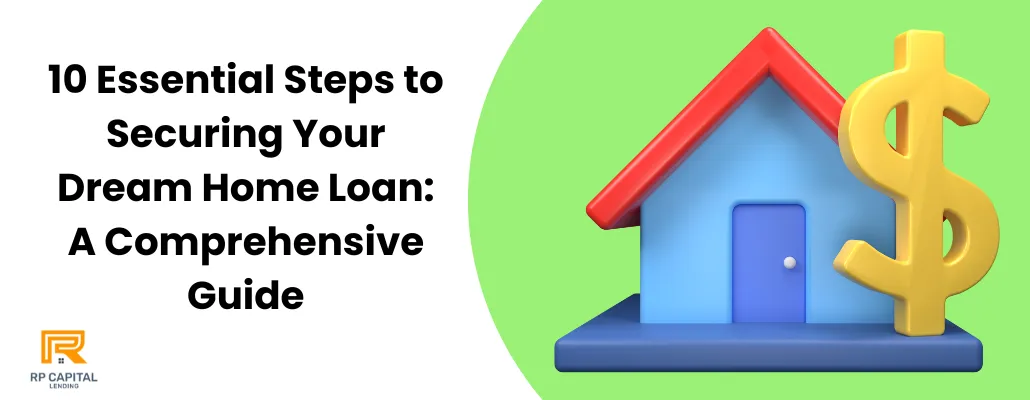Blog

10 Essential Steps to Securing Your Dream Home Loan: A Comprehensive Guide
Embarking on the path to homeownership is an exhilarating journey that begins with a critical step: understanding your home loan options. This initial phase is pivotal as it lays the foundation for making informed decisions that align with your financial goals and dreams of owning a home.
The right knowledge about home loans not only empowers you but also demystifies the complex process of buying a house. With myriad loan options available, each offering different terms, rates, and benefits, the importance of comprehending these choices cannot be overstated.
This guide aims to illuminate the path towards securing your dream home loan, ensuring you are equipped with the necessary tools and information to navigate the home-buying landscape confidently. Let's dive into the essentials of home loans, helping you to unlock the door to your future home with confidence and ease.
1. Understanding Home Loans
The Basics of Home Loans
A home loan serves as a bridge to homeownership, offering a way to finance the purchase of your dream home without the need for upfront, full payment. It's a financial agreement with a lender to borrow money, secured against the value of the property.
This loan is repaid over an agreed period through monthly payments that include both principal and interest components. Understanding the basics of home loans is crucial for potential homeowners. It helps in making informed decisions about what kind of loan best suits one's financial situation and long-term goals. Whether you're a first-time homebuyer or looking to refinance, grasping the fundamentals of mortgage types, interest rates, and repayment terms can significantly impact your financial future.
Types of Home Loans: Which One Suits You?
Selecting the right type of home loan is a pivotal decision that can influence your financial health for years to come. The market offers various home loan options, each tailored to different needs and circumstances.
Fixed-rate mortgages offer stability with consistent monthly payments, making budgeting easier. Adjustable-rate mortgages (ARMs) might start with lower rates, which can change over time, affecting your payments. Government-backed loans, such as FHA, VA, and USDA loans, provide opportunities for those who might not qualify for conventional loans, often requiring lower down payments or offering more favorable terms.
Understanding these options allows borrowers to make choices that align with their financial situation, preferences, and future goals, ensuring a more secure and tailored path to homeownership.
2. Preparing for a Home Loan
Assessing Your Financial Health
Before embarking on the home loan application journey, assessing your financial health is a crucial step. This assessment involves a thorough review of your income, expenses, savings, and debts. Understanding your financial standing helps in determining how much you can afford to borrow and repay without straining your finances.
It's also a vital step in preparing for the pre-approval process, as lenders will scrutinize your financial health to assess your loan eligibility. By evaluating your financial health early, you can make necessary adjustments, such as improving your credit score or paying down debts, to enhance your loan approval chances and secure favorable loan terms.
The Importance of Credit Scores in Home Loan Approval
Your credit score is a critical factor in the home loan approval process, acting as a measure of your creditworthiness to lenders.
A high credit score can unlock lower interest rates, making your loan cheaper over time, while a lower score may result in higher rates or even loan denial. Lenders use your credit score to assess risk; a higher score indicates a history of responsible credit management, suggesting a lower risk of default.
Understanding the importance of your credit score can motivate you to improve or maintain good credit habits. Regularly monitoring your credit report, paying bills on time, reducing debt, and avoiding new credit inquiries can help boost your score, ultimately leading to better loan terms and a smoother loan application process.
3. Exploring Home Loan Options
Fixed-Rate vs. Adjustable-Rate Mortgages
Choosing between a fixed-rate and adjustable-rate mortgage (ARM) can significantly impact your financial future. Fixed-rate mortgages lock in an interest rate for the duration of the loan, providing stability and predictability in monthly payments.
This makes budgeting easier, as your loan payments remain constant, regardless of market fluctuations. On the other hand, ARMs start with a lower interest rate, which can adjust over time based on market conditions. This option might seem appealing due to the initial lower payments, but it carries the risk of future payment increases. Understanding the pros and cons of each can guide you in choosing a loan that matches your financial stability and risk tolerance.
Government-Backed Loans: FHA, VA, and USDA Explained
Government-backed loans offer unique benefits that can make homeownership more accessible. FHA loans, backed by the Federal Housing Administration, are popular among first-time homebuyers due to lower minimum down payment and credit score requirements.
VA loans, guaranteed by the Department of Veterans Affairs, are available to veterans and active military members, offering benefits like no down payment and no private mortgage insurance (PMI). USDA loans, supported by the United States Department of Agriculture, aim to help buyers in rural and suburban areas, offering 100% financing and reduced mortgage insurance costs.
Each of these loans caters to specific borrower needs, making it essential to understand their criteria and benefits to determine the best fit for your homeownership goals.
4. The Home Loan Application Process
Step-by-Step Guide to Applying for a Home Loan
Applying for a home loan can seem daunting, but breaking it down into steps can simplify the process. It typically starts with pre-qualification, giving you an idea of how much you might afford, followed by pre-approval, where lenders verify your financial information to offer a more precise loan amount.
The next steps involve choosing the right loan option, submitting a formal application with all required documentation, and awaiting the lender's approval. Understanding each stage of the application process can demystify it, making you better prepared and more confident in navigating it successfully. It's also an opportunity to address any financial issues that might arise, ensuring a smoother path to loan approval.
Documents You Need for Your Home Loan Application
Preparing the necessary documents for your home loan application is a critical step towards approval. Lenders typically require proof of income, employment verification, credit history, asset statements, and identification, among others.
Gathering these documents in advance can expedite the application process and improve your chances of a smooth approval. It's also a good opportunity to review your financial health, ensuring all information is accurate and up-to-date.
Being organized and thorough with your documentation can demonstrate to lenders your reliability and seriousness about the home buying process, potentially leading to more favorable loan terms.
5. Interest Rates and Fees
Understanding Interest Rates
Interest rates are a pivotal factor in determining the cost of your home loan. They can vary based on market conditions, the lender, and your creditworthiness. A lower interest rate means lower monthly payments and less money paid over the life of the loan, making it crucial to understand how rates are determined and what you can do to secure a favorable rate.
Shopping around and comparing offers from multiple lenders can help you find the best rate. Additionally, factors such as improving your credit score, choosing the right loan term, and making a larger down payment can also influence the interest rate you receive.
Decoding Fees and Charges in Home Loans
Home loans come with various fees and charges that can significantly affect the total cost of your loan. These can include origination fees, appraisal fees, closing costs, and more. Understanding these fees and their purpose can help you budget more accurately and avoid surprises during the loan process.
Some fees are negotiable, and shopping around can help you compare and minimize costs. Being informed about the potential fees and actively engaging in discussions with your lender can lead to more transparency and potentially lower overall loan costs.
6. Home Loan Approval Process
What Happens After You Apply?
After submitting your home loan application, it undergoes a process of verification and assessment by the lender. This includes a review of your financial documents, credit history, employment verification, and property appraisal.
The lender's goal is to assess your ability to repay the loan and the property's value as collateral. During this time, it's important to maintain your financial stability and avoid making significant changes, such as changing jobs or making large purchases, as these can impact your loan approval.
Understanding what happens after you apply can help set realistic expectations and prepare you for the next steps in your home buying journey.
Common Reasons for Home Loan Rejection and How to Avoid Them
Home loan applications can be rejected for various reasons, including low credit scores, high debt-to-income ratios, unstable employment history, or issues with the property. Understanding these common pitfalls can help you take proactive steps to strengthen your application. Improving your credit score, paying down debts, and ensuring stable employment can enhance your loan approval chances.
Additionally, choosing a property that meets lender requirements and is in good condition can also play a crucial role. Being aware of and addressing these factors can help you navigate the loan process more smoothly and increase your chances of approval.
7. Closing Your Home Loan
Final Steps Before Closing
The final steps before closing your home loan include reviewing the closing disclosure, which outlines the terms of your loan, closing costs, and other details. It's important to carefully review this document and clarify any uncertainties with your lender.
This is also the time to secure homeowner's insurance, which is required before closing. Preparing for the closing involves ensuring all necessary documents are in order and funds for closing costs and down payment are available. Understanding and completing these final steps can ensure a smooth transition to closing, bringing you one step closer to homeownership.
What to Expect on Closing Day
Closing day is the culmination of the home buying process, where the transfer of property ownership takes place. Expect to sign a lot of paperwork, including the mortgage agreement and property deed. This is also when you'll pay any remaining closing costs and the down payment.
It's a good idea to review all documents carefully and ask questions if anything is unclear. Understanding what to expect on closing day can help alleviate stress and make the experience more enjoyable. After all, it marks the beginning of a new chapter as a homeowner.
8. Managing Your Home Loan
Tips for Managing Your Mortgage Payments
Successfully managing your mortgage payments is crucial for maintaining financial stability and eventually owning your home outright. Setting up automatic payments can ensure you never miss a due date, potentially saving you from late fees and negative impacts on your credit score.
Additionally, understanding the benefits of making extra payments towards your principal can accelerate your mortgage payoff and save you interest in the long run. Budgeting for your mortgage payment and associated costs, like property taxes and insurance, is also essential. Proactively managing your mortgage can lead to a more secure financial future and possibly even early loan payoff.
Refinancing: When and Why?
Refinancing your home loan can offer several benefits, including lower interest rates, reduced monthly payments, or a shorter loan term. It's typically considered when market interest rates drop significantly below your current rate or when your financial situation and credit score have improved.
Refinancing can also be used to switch from an adjustable-rate mortgage to a fixed-rate mortgage for more predictable payments. However, it's important to consider the costs associated with refinancing, such as closing costs, and whether the long-term savings outweigh these expenses.
Understanding when and why to refinance can help you make informed decisions that align with your financial goals.
9. Avoiding Common Pitfalls
Top Mistakes to Avoid in the Home Loan Process
Navigating the home loan process can be complex, and certain mistakes can hinder your path to homeownership. One common mistake is not checking your credit report for errors, which can affect your loan approval and terms.
Another is failing to shop around for the best loan rates and terms, potentially costing you thousands over the life of your loan. Additionally, overlooking the total costs of homeownership, including taxes, insurance, and maintenance, can strain your finances.
Being aware of and avoiding these mistakes can lead to a smoother loan process and more favorable loan conditions.
How to Deal with Financial Challenges
Financial challenges can arise at any point during the lifespan of your home loan. Whether it's a job loss, unexpected expenses, or changes in your financial situation, it's important to communicate openly with your lender. Many lenders offer options for forbearance, loan modification, or refinancing to help you manage your payments during difficult times.
Additionally, creating an emergency fund and regularly reviewing your financial plan can provide a buffer against unforeseen challenges. Proactively managing financial difficulties can help you maintain your home loan commitments and protect your investment in your home.
10. Future Trends in Home Loans
The Impact of Technology on Home Loans
Technology is revolutionizing the home loan industry, making the process more efficient and accessible for borrowers. Online applications, digital document submission, and automated underwriting are streamlining the loan approval process.
Technology is also enhancing the way lenders assess creditworthiness, potentially expanding access to home loans for a broader range of borrowers. Additionally, online platforms and apps are providing borrowers with more tools and resources to compare loan options, understand terms, and manage their mortgages.
Staying informed about technological advancements can help you navigate the home loan process more effectively and take advantage of emerging opportunities.
Predictions for the Home Loan Market
The home loan market is influenced by economic conditions, government policies, and technological advancements. Predictions for the future include continued growth in the use of technology to simplify the loan application and management process. Interest rates are likely to fluctuate based on economic trends, affecting affordability and borrowing costs.
There may also be an increase in alternative lending options, offering more flexibility for a variety of borrowers. Understanding these trends can help you make informed decisions when considering a home loan, ensuring you choose the best option for your financial future.
Conclusion
Understanding your home loan options is the first step towards homeownership. This guide has walked you through the essentials, from preparing for a loan to managing your mortgage. With the right preparation and knowledge, securing your dream home loan can be a smooth and rewarding process.
FAQs
1. What is the difference between APR and interest rate?
While the interest rate represents the cost of borrowing the principal loan amount, APR includes the interest rate plus other costs such as broker fees, discount points, and some closing costs, providing a more comprehensive cost of the loan.
2. Can I qualify for a home loan with a low credit score?
Yes, it's possible, especially with government-backed loans that offer more lenient credit requirements. However, a higher credit score can secure better loan terms.
3. How much down payment do I need?
The down payment depends on the type of loan and lender requirements. While some loans, like VA loans, may not require a down payment, conventional loans typically require between 3% and 20%.
4. What are the benefits of a fixed-rate mortgage?
A fixed-rate mortgage offers stability with the same interest rate and monthly payment for the life of the loan, making it easier to budget.
5. Should I choose a 15-year or a 30-year mortgage term?
Choosing between a 15-year and a 30-year mortgage depends on your financial situation and goals. A 15-year loan will have higher monthly payments but lower total interest, while a 30-year loan offers lower monthly payments but higher total interest.
Disclaimer: Loans only apply to non-owner occupied properties. Rates, terms and conditions offered only to qualified borrowers, may vary upon loan product, deal structure, other applicable considerations, and are subject to change at any time without notice.
Copyright © 2025. All Rights Reserved.


